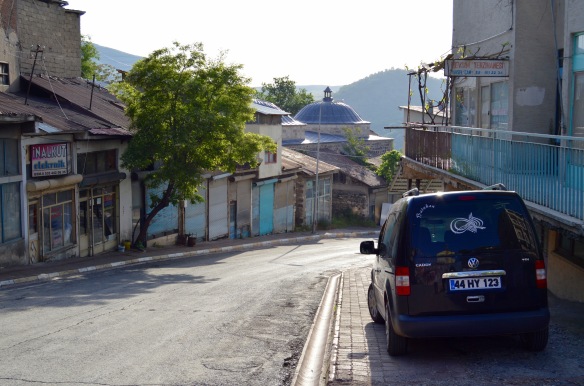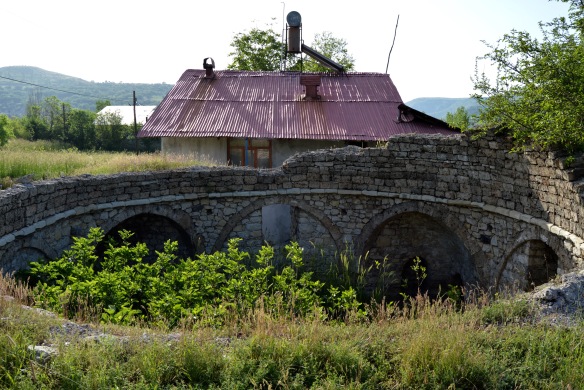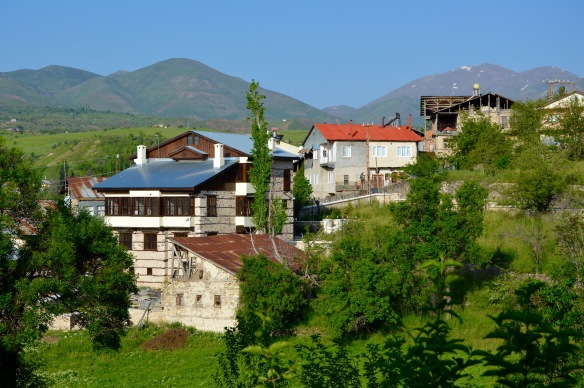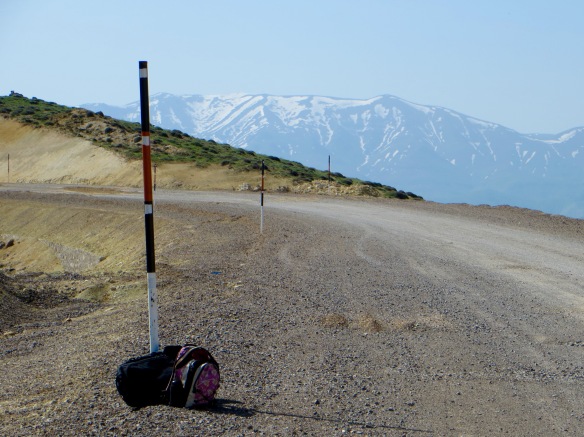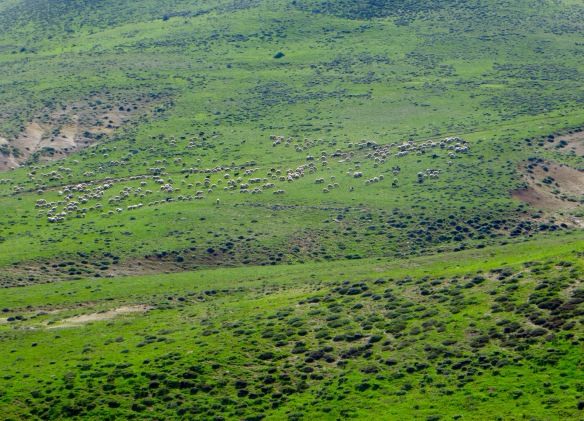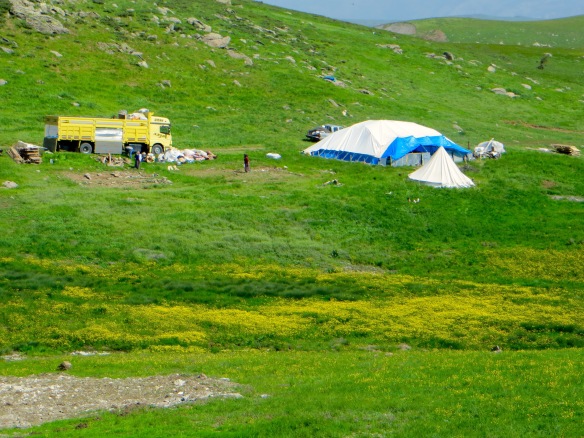The Mayd Hotel in Elazig was at number 11 Horasan Sokak, but Horasan Sokak was better known locally as Kofteciler Sokak because of the large number of lokantas, many of which served meatballs. The place where I ate twice the day before was just off Horasan Sokak and other lokantas were along the same street as well as at least five nearby ones.
Keen to make an early start just in case getting from Keban to Arapgir proved a problem, I was eating breakfast by 7.00am and impressed with what the two-star hotel provided (I was correct. With a woman in the kitchen, the food was better than normal). Beside all the usual items such as olives, cheese, sliced meat, tomatoes, cucumber, bread, butter, jam, honey, chocolate spread flavoured with hazelnuts and boiled eggs, there were lentil soup, yoghurt, simit, borek stuffed with egg and vegetables, cooked tomatoes and peppers, fried potatoes and as much tea and water as my body required. I went for broke and tried just about everything, enjoying in particular the borek, yoghurt, honey and sour cherry jam. If I had problems later in the day with transport, I could get to the evening before having to eat again.
I settled the bill and left for the minibus garaj I had arrived at the day before. By utilising a short cut through the side streets, I got to my destination in under 15 minutes. The next minibus to Keban was leaving at 8.30am; I had almost half an hour to wait. I chatted with a man bound for Keban and the nearby dam.
Two boys, one with a grubby improvised bandage on his hand, approached us and asked for money. Aged about eight and ten, the boys were Syrians displaced by the civil war that had raged for three years and was now further complicated by the emergence of the Islamic State. We did not learn much about their circumstances. Were they alone? Had their parents died or were they alive but not with them in Elazig? I gave them some money. They thanked me and slowly walked away counting the coins in their hands.
I was reminded that Turkey was now caring for 1.8 million people displaced by the conflicts in Syria and Iraq. 1.8 million people. This was a humanitarian exercise for which Turkey deserved international recognition and immense praise. But we in the UK had refused to take just a few thousand of the vast number of people who had fled poverty or conflicts in the Middle East, North Africa or sub-Saharan Africa and crossed the Mediterranean to be cared for in Greece or Italy.
The UK used to have an enviable reputation for providing people in need with a place of sanctuary. Despite our relative wealth, we are now increasingly inward-looking, xenophobic and intolerant of people seeking the same life chances as us. But you know what makes this so ridiculous? If every UK citizen looks back far enough into his or her family history, he or she will discover something we all have in common. We are all foreign in origin. Even the people who have inhabited the islands of Britain the longest, people of Celtic descent in Northern Ireland, Wales, Scotland and Cornwall, are foreign in origin. The point I am making is this. If we are all foreign in origin, how can we deny to other people the opportunity to migrate to the UK, especially if they are migrating for precisely the same reasons our ancestors did? The suggestion that we are already full is nonsense. Even our densely populated urban areas in south-east England have lots of plots of land that can be developed to good effect, and I am not including the plots of land that are parks or green open spaces which must remain exactly as they are for the well-being of people, flora and fauna.
Before the civil war, Syria was the Middle East’s most intriguing nation state because of the ethnic, cultural and linguistic mixture of its people; the considerable beauty of some of its landscapes and many of its urban areas; and because of its remarkable monuments, some of which had survived from thousands of years ago. But now, at least 150,000 people have been killed, millions of Syrians are refugees, vast swathes of urban Syria resemble Gaza after it has been bombed by the Israelis, and the Islamic State is doing all it can to destroy monuments that it deems unIslamic (recent reports suggest that the wonderful desert city of Palmyra is the latest world heritage site to attract the Islamic State’s hatred of things not Muslim).
Even if peace breaks out in Iraq tomorrow, it is obvious that the great majority of non-Muslim Iraqis will not return to their homes because they believe that they will never again be certain of their safety and security in an overwhelmingly Muslim nation state. Unless the civil war ends soon in Syria and the Islamic State is crushed forever, the great majority of non-Muslim Syrians will not return to Syria for precisely the same reason. And who, in the end, will be the biggest losers because of disrupting the delicate ethnic, cultural and linguistic balance that once existed in both nation states? The people who remain in Iraq and Syria, the vast majority of whom will be Muslims.
Already, too many Middle Eastern and North African nation states have suffered the loss of minority groups, thereby becoming far more monocultural than they have ever been. The question for the future therefore becomes this. Can the few overtly multiethnic nation states in the region such as Egypt, Jordan, Lebanon, Turkey and Israel remain as diverse as they currently are? The indicators are not encouraging. Coptic Christians in Egypt live in constant fear that they will be subjected to massacres in their residential districts or bomb attacks in their churches; religious minorities in Jordan know it is only a matter of time before Islamist inclinations gain greater popularity among the Sunni Muslim majority; the Lebanese fear that the war in Syria will once again ignite conflict among its ethnic and/or confessional communities, but in any future conflict, non-Muslims will not be able to defend themselves as effectively as in the past; Turkey is far less multiethnic than it was even a generation ago; and Israel is increasingly blighted by Jewish religious fundamentalism of the most alarming kind, fundamentalism that often morphs into racism directed against the Arabs in general and the Palestinians in particular. Such Jewish racism is sufficiently violent in its rhetoric and physical expression to have already driven some Palestinians from their homes. Moreover, such racism causes growing numbers of Jewish people in the diaspora, and many non-Jewish people who support the existence of the state of Israel, to despair that peace with the Palestinians will ever be achieved.
As my trip to Turkey was confirming, Turkey could emerge as an exception to the rule in this troubled part of the world. Yes, Turkey has seen an alarming decline in the extent to which it is an ethnically, culturally and linguistically diverse nation state since the 1950s, but all sorts of substantive and symbolic indicators point toward a growing number of Turkish nationals, whether ethnic Turks or Kurds, anxious to celebrate the diversity of the country’s population, past and present. The Greek and Jewish populations may now be only a few thousand strong each, but the Armenian population seems to have stabilised at around 70,000, although it is evident that some people who describe themselves as Turks, Kurds or Laz are in reality Islamicised Armenians. Because a majority of them are Muslims, no one need worry too much about the long-term prospects for the Arabs, Georgians or Laz in Turkey, and it cannot be denied that, since the war with the PKK concluded a few years ago, prospects for Turkey’s Syriac Orthodox Christians have improved significantly. Instability in Syria and Iraq might increase the size of Turkey’s very small Yazidi and Chaldean communities (leaders in both communities say that many of their people never want to live in Syria or Iraq again), but for Yazidis and Chaldeans to remain or settle in Turkey, they will need convincing guarantees from the Turkish government that sympathy for their dire plight is not merely a temporary phenomenon.
I am more confident about the prospects for multiethnicity in Turkey than in any of the other nation states just identified, but I also realise how quickly things can change in the Middle East. Should conflict once again break out between the PKK and the Turkish government, all the good work of the last few years will be undone in months. It could also be undone in a few months if the AKP tries to impose a legislative programme more Islamist than it has proposed to date, or if Turkish nationalists of the more extreme kind allege that Turkey’s minorities pose threats to the integrity of the republic and/or idealised notions of what it means to be a Turk. There is a lot at stake in the forthcoming general election, believe me.
Although my love affair with Turkey began in 1978, there are still things about the country that bring tears to my eyes, sometimes for good reasons and sometimes for bad. Tears come to my eyes for good reasons because of the astounding hospitality and friendliness of most of the people; the way that things almost always fall into place when visitors need transport, accommodation, food or drink; how easy it is to find places that should be internationally renowned despite very few people knowing about them; and how Turkey has provided sanctuary for so many refugees from recent and on-going Middle Eastern conflicts. Tears come to my eyes for bad reasons because of the barriers that still remain for the great majority of people with disabilities, special needs and learning difficulties; the discrimination that confronts all the country’s minority ethnic groups and its gay, lesbian and bisexual communities; the poverty that exists in many rural communities, especially in eastern Turkey; the gender inequality that penalises millions of girls and women in countless substantive and symbolic ways; and the boundless energy, enterprise and intelligence that lie untapped among a majority of the country’s female population because, other than in a few sectors of society in which secular principles have not given way to Islamic ones, girls and women cannot compete as equals with boys and men. Today turned out to be one of the days when I often fought back the tears, and occasionally for some of the reasons just listed.
Because the 50 kilometre journey to Keban in a comfortable minibus cost only 5TL, or about £1-30, I tried to work out how much a bus journey of a similar distance would have cost in the UK. £4-50 to £5 seemed about right. The fare to Keban was very small despite the fact that petrol in Turkey was almost the same price as in the UK, thereby making it very expensive in relation to the average income, which was about a fifth or a sixth that of the average income in the UK.
The minibus went past the football ground, the incomplete park with the water features, the large dental hospital, lots of very new apartment blocks of crisp and clean design, the Ramada Hotel and a wall painting of Ataturk dressed in a soldier’s uniform while sucking a cigarette. Some progress had been made in recent years to convince Turkey’s citizens that smoking was a danger to their health, so much so that many people no longer smoked and far fewer smokers offered cigarettes to people they knew, which were both in marked contrast with past decades. However, smoking remained more popular in Turkey than in the UK and seemed to have been taken up by more women in recent years. It was still quite rare to see pious women in headscarves smoking, but the ones that did were usually earning a living in a full- or part-time job while still constrained by all the responsibilities of motherhood and home-maker. It was the start of day five of the trip and I had smoked only two cigarettes since arriving in Diyarbakir. I never smoke at home and have not done so for at least a decade, and for the decade before that, I confined consumption of the evil weed to only the occasional cigar. But the flesh is weak.
Elazig had spread so far to the west that it was only when we arrived at the turning for Sahinkaya that we escaped the clutches of the city. I had never travelled the road to Keban before. The gently undulating terrain was dominated by fields, pasture, orchards and grapevines, and hills and mountains were always in the distance. Some of the orchards produced apricots and many of the apricots found their way to Malatya, the city in the centre of one of the world’s best regions for their production. As I was soon to find out, some of the grapes were turned into wine and quite a lot of the wine was consumed locally by Alevis and Bektashis. In fact, I was temporarily leaving the Sunni side of the street for an area dominated by Alevis. It was almost as if I was leaving one nation state for another.
For most of the way to Keban, lots of wild flowers grew in the long grass. There were many places where beehives had been arranged in lines not far from sources of nectar and pollen. We passed a large modern mosque built where only five houses were in walking distance. I was reminded that Alevis and Bektashis rarely engaged in ritual practices in mosques. I knew for certain that the mosque will have been recently built in the hope that Alevis and Bektashis could be persuaded to adopt mainstream Sunni Islam. Was there much chance that this would happen? No, and above all because of the discrimination that Alevis and Bektashis had suffered for centuries at the hands of Sunni Muslims.
Almost every village along the road to Keban had a new mosque and the mosque was always far larger than the size of each village justified. The AKP had engaged in a massive mosque-building programme in recent years, but in all the parts of Turkey with substantial Alevi and Bektashi populations, its efforts to reinforce the influence of Sunni Islam had been largely unsuccessful. How sad that such a lot of money and effort had been wasted on a pointless exercise.
We drove beside Poyraz, a widely dispersed village. Just beyond the settlement, a road veered off to the north and led to the vast and elongated Keban Reservoir where a ferry carried vehicles and passengers to the north shore from where another road led after a few kilometres to the town of Cemisgezek, which I hoped to visit in a few day’s time.
The road gradually ascended for quite a long way and every so often we passed very large modern houses that had been carefully designed and brightly painted. The houses belonged to guestworkers who, on retiring from their jobs in countries such as Belgium, Germany or the Netherlands, were rich enough to build exactly what they wanted in the area where they had been born.
We reached the highest point on the road and mountains dominated the view ahead. We began to gradually descend, but drew to a halt at a road junction where a man wanted a lift to Keban. A sign indicated that the road led to two villages. The villages were 3 and 11 kilometres away. In Turkey, such signs tempted me to take a detour even if they might to lead to nowhere of great importance. However, I knew that the chances of something interesting lying along the road were very high, so the risk of being disappointed was very small.
When the baby in front of me dropped his dummy, I reached forward to pick it up. I handed the dummy to the young mother, but she did not acknowledge my existence in the slightest way. I was not surprised because she wore a headscarf and was dressed in a manner that confirmed she was a conventionally pious Sunni Muslim who should have no contact with an unknown male.
The road entered a meandering valley, but remained above the river. A few minutes later, we arrived at the edge of Keban and I got off the minibus at the point where a road to the left led downhill into the centre of the old town.
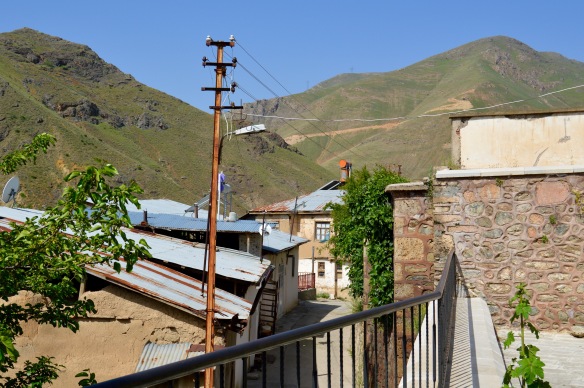
Keban.
People confirmed that minibuses did not travel between Keban and Arapgir, but I was not unduly worried because it was just after 9.30am. Since Keban was small and situated in such pretty surroundings with hills pressing against it on all sides, I decided to walk into the town centre because the minibus driver had told me earlier that there was a pretty mosque and an old church.
Keban stood on a slope above a narrow tributary of the Euphrates. It was a town of considerable importance until the mid-19th century because of nearby lead and silver mines, the abandonment of which caused the settlement’s population to decline. When the mines were open, smelting took place locally. Many of the miners were Greeks, but Sinclair suggests that “there was always a Turkish supervisor”.
In the 1830s, Germans and Hungarians worked one of the lead mines, but in 1840, Austrian engineers arrived and improved production for a short period of time. The main problem that confronted the miners and engineers was the lack of wood for smelting, so in the 1840s, attempts were made to force the people living in nearby villages to supply wood. But such coercive efforts resulted in people leaving the villages and the males becoming brigands or bandits. Production dwindled and the mines and furnaces were abandoned for good in about 1871.
The very pretty mosque was Yusuf Ziya Pasa Camii. It was part of a kulliye, or complex, and therefore proved an unexpected delight. Sinclair notes that the mosque and its related buildings dated from 1795 or 1796:
The mosque lies at the s. side of a courtyard dug out of the hillside. The dome is taken on four slim, widely spaced pillars. Between the pillars and the walls are sprung high pointed vaults. The dome and space beneath it are broad, airy and light in relation to the thinner, darker vaults. Women’s gallery to the n. The mihrab is plain, but the stone mimber is excellently decorated… The son cemaat yeri is a portico on pillars whose pitched roof continues the slope of that covering the prayer hall. It has a single dome (in the middle). The minaret to the w. is clear of the prayer hall’s wall and was built two years later than the prayer hall. It has an octagonal base: the slender shaft is twelve-sided.
Library. This is to the w. of the courtyard. It is on two storeys and domed. The dome sits on an octagonal drum which is pierced with windows. Next to the library is the medrese. Turbe for Ziya Pasa’s daughter. It is square with two windows in each wall (except that one window is replaced by the door) and domed. By the turbe is a cesme whose shallow iwan has a keel-shaped vault… Of the caravansaray only the portal and parts of the walls stand. By the entrance there are animal reliefs and other decoration.
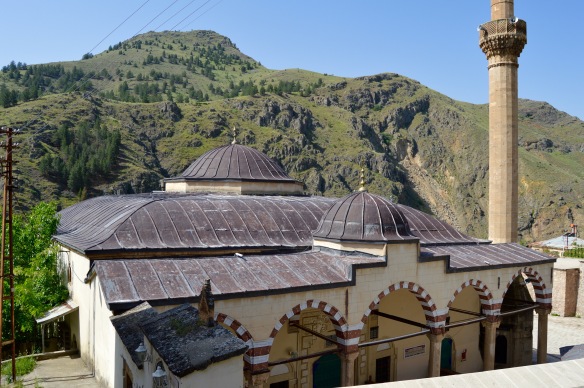
Yusuf Ziya Pasa Camii, Keban.

Yusuf Ziya Pasa Camii, Keban.
I walked the short distance to the church, which Sinclair says was Armenian. It had a basilican layout and the faintest remains of frescoes on the walls. The roof was intact. The windows, whether still in existence or blocked with stone, were easily identified externally. Internally, I was confronted with columns supporting semi-circular arches. The structure was in such good condition that the Belediye, or Town Council, used it to shelter some of its motor vehicles, dustcarts included.
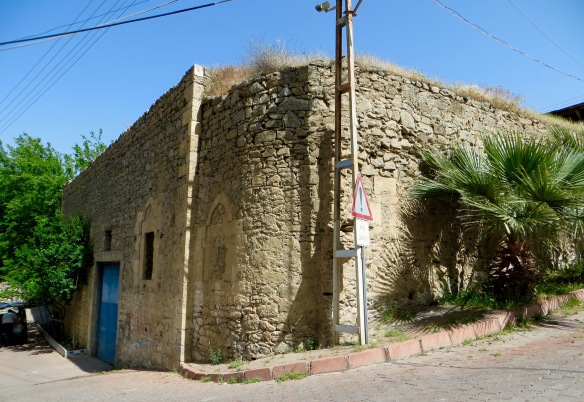
The Armenian church, Keban.

The Armenian church, Keban.

The Armenian church, Keban.

The Armenian church, Keban.
The doorway leading into the church faced the local police station where a few officers engaged me in conversation as they stood on the steps leading inside. One officer held a large automatic rifle which hung from a strap over one shoulder and the others had handguns in holsters attached to belts around their waists. I was offered a large glass of tea, for which I was very grateful. After an officer received a message on his phone, he and two of his colleagues made their way to a police car and prepared to leave to sort out a problem. Amazingly, I was asked to join them, which must have meant it was a minor problem, but I had to leave for Arapgir just in case traffic on the road proved very light. I walked to the office of a bus company running services to Elazig and elsewhere because I had dropped off my large bag to save carrying it around. I thanked the young man for looking after it and walked up the hill to the main road from Keban to Arapgir, noting along the way that many old houses had survived in the town. In fact, Keban had much to commend it, although it appeared to lack a hotel in which to stay.
I stood in the shade of some trees waiting for a lift, but the traffic was light and most drivers indicated that they were going only a short distance, most of them to the dam holding back the vast Keban Reservoir. The dam made quite an impressive sight. It was 1,125 metres long and a maximum of 210 metres high. Below the dam was a fish farm and below the fish farm a bridge carried the road to Arapgir across the river.

The dam, Keban Reservoir.
About half an hour after taking shelter under the trees, a man stopped his car and drove me into the quite wide valley below the dam. I was dropped at the south end of the bridge where a dirt road veered to the left to follow the river. The man was driving along the dirt road to check that everything was going well at a second fish farm. I walked across the bridge and, at the north end, bunting for one of the political parties flapped in the gentle breeze. Beside the river was a lokanta specialising in grilled fish from the nearby fish farm, but it did not look as if any eating would take place on the day I saw it.

The fish farm, near Keban.
I had to wait about only 15 minutes for the next lift and, on this occasion, was taken by a very jovial Alevi man and his son aged five all the way to the junction for the road to Malatya. The man farmed in a nearby village and one of his main crops was grapes. By now the road had ascended quite some height above the river valley and we were some distance onto an undulating plain. Snow-smudged mountains were shadowy presences in the distance. The mountains were the ones I hoped to get through the following day on my way to Divrigi.
I said goodbye to my hosts at the junction for Malatya and the man and his son waved as their motor vehicle turned around. The man had driven me some distance out of his way to ensure I would have a better chance of a lift to Arapgir. Amazing. Such kindness.
Ten minutes later, I was in a large lorry delivering goods to the centre of Arapgir, so all my worries about travelling from Keban had proved unfounded. Along the last section of the journey, we passed some very large flocks of sheep and the first tents set up by semi-nomadic families to care for the animals during the summer months. Some of the tents were bell-shaped. A few donkeys were tethered nearby. To the east, another ridge of mountains was smudged with snow.
We turned off the road leading to Divrigi and began the descent to the centre of Arapgir. We went through the pretty suburb of Asagiulupinar, which had once been a village. I had been to Arapgir once before, but only on a day trip from Malatya. I now intended to stay overnight to see what I had missed on the last occasion, Eskisehir, or old Arapgir. Eskisehir was a few kilometres to the north of the modern town.

Arapgir.
I thanked the driver of the lorry for his kindness, then walked the short distance to the relatively new Arapgir Nazar Hotel, one of two hotels that had opened in the town since my last visit a few years ago. I entered the very clean and attractively decorated lobby and was offered a room with en suite facilities and breakfast for 50TL for the night. The person at reception was a young female aged about 22 who did not wear a headscarf. The owner and his daughter appeared from along a corridor and I was invited into the man’s office where I was offered coffee. The three of us immediately got on well, partly because my companions were liberal Alevis with no time for the constraints of Sunni orthodoxy, and partly because we agreed that it would be wonderful if the forthcoming general election ensured that the AKP did not dominate Turkish politics in the way it had done for over a decade. A picture of Ataturk hung on the wall above the large desk behind which the man sat, confirmation that the family would vote for one of the secular parties when the election took place.
I was asked why I had decided to stay overnight in Arapgir and whether I would travel the following day to Kemaliye, a small town on the Euphrates River about 30 kilometres to the north. I explained that Divrigi was my next destination, although I knew that Kemaliye had much to commend it, and I explained about Eskisehir, which I had not visited when last in Arapgir. My hosts could not understand the appeal of Eskisehir, but, as I found out later, this was because they did not know much about it. But what they did know about was a village called Onar about 15 kilometres from Arapgir where there were 18 rock tombs dating from the Roman era and a 13th century cemevi, or meeting house, for Alevis and Bektashis to engage in ritual practices. They asked if I wanted to visit Onar. When I said that I did, the man said, “Then we will leave in half an hour. Get ready and we will go in our car.” I could not believe my luck.
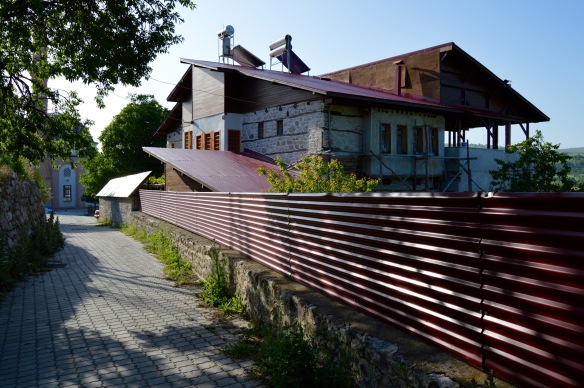
Arapgir.

